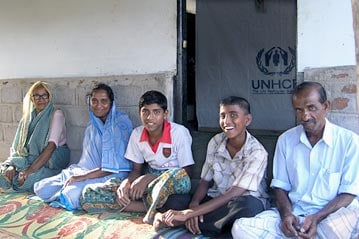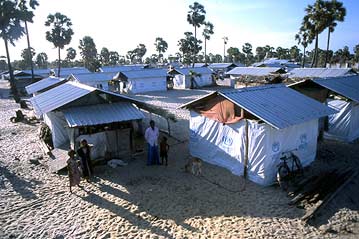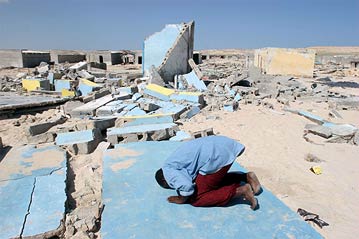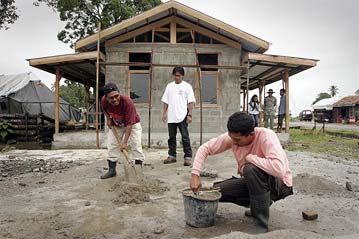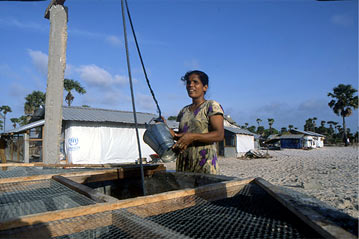Tsunami response: Indonesia
Tsunami response: Indonesia
During the week, UNHCR has been using Swiss helicopters in a shuttle operation to transfer 18 tonnes of shelter materials from our operational base at Calang on Aceh's west coast to the village of Krueng Sabe, 8 km south of Calang. The village was badly hit by the tsunami and has received little assistance so far. An estimated 50 percent of Kreung Sabe's population were swept away by the waves, leaving some 4,000 people displaced. Displaced people from five surrounding villages have now gravitated to the town to get assistance. UNHCR has helicoptered in lightweight tents, plastic sheeting, hygiene kits and blankets for some 3,000 people.
The helicopters are scheduled to continue flying supplies into Kreung Sabe for at least another day from where distribution of the relief items is underway. Community leaders of the surrounding villages have constructed small warehouses made of wood and plastic sheeting from the rubble of the destroyed former town centre, from where local transport is being used to get the relief items to their villages.
Our Calang team is currently assessing transferring relief supplies to the severely hit village of Keude Panga, further south from Calang.
In Lamno, since we opened our office ten days ago, we have distributed a total of 159 family-sized tents, 1,568 blankets and 754 kitchen sets to displaced people, IDPs. The number of IDPs is estimated at 14,000, of whom 3,500 are living with host families and the rest in spontaneous settlements. Tents, blankets and kitchen sets were distributed to host families as well as IDPs. IDPs have continued to arrive over the past weeks from Calang by boat and some from the villages around Lamno.
A team from UNHCR and UNDP on Thursday visited the town of Teunom (pronounced teeh-nomh) on the west coast, some 60km to the north of Meulaboh, where thousands of displaced people continue to survive a month after the tsunami disaster mainly on a diet of bananas, coconut and palm fruit, locally called sagu. The French aid agency ACF - Action Against Hunger [Action Contre la Faim] - has begun food distribution in the area using supplies from the World Food Programme airlifted by French army helicopters. The airlift began on Wednesday. American and German Red Cross workers have been in the area providing medical, water and sanitation facilities since early this month, but food and shelter remain critical needs.
Aid workers, using figures from local authorities, say Teunom's population was originally 17,000. About 2,000 reportedly perished in the tsunami disaster. Some 8,000 people have been displaced, 80 percent of them living with host families and the rest in damaged mosques, public buildings and a few tents. This figure includes those from neighbouring villages. ACF says it has established 21 distribution points where pockets of displaced from 50 to 500 have been identified. Residents say the Indonesian army has distributed rice, biscuits and noodles to some of the displaced.
Few buildings stand in Teunom, one of the hard-hit towns along the west coast of Aceh province that have been inaccessible to organized relief efforts. No cleanup has taken place in the area. Some residents have been scavenging in the debris and putting together ramshackle houses in their demolished property. The stench of death is pervasive a month after the disaster. The area is cut off from the nearest main city of Meulaboh with large portions of the asphalt road and bridges destroyed. The harbour has been damaged and only very small boats can enter the port. Supplies can only be flown in by helicopter.
UNHCR is preparing to fly in to the area some of the 250 "shelter boxes" donated by Rotary International and brought by a convoy of eight trucks on Thursday to our satellite office in Meulaboh. Each box is for 10 people and contains blankets, a torch, a shovel, water purifying tablets, cooking and drinking containers.
In Meulaboh, the first UNHCR-built camp in the area will begin to receive displaced people over the weekend when latrines and water facilities being installed by Oxfam are completed. This camp has 112 tents for about 560 persons living till now with host families. It will be run by Indonesian authorities.
Work on a second UNHCR camp began on Wednesday at Alu Peunyareng (pronounced ahh-looh penh-yah-rehng), 15 km south of Meulaboh. This camp will shelter around 350 families living in appalling conditions in an army-built barracks in the city. Distribution of non-food items has been continuing in the Meulaboh area. So far, we have distributed non-food items to more than 1,100 families in the Meulaboh area.
In all places we are trying to cater for the most needy, with immediate relief supplies. At the same time UNHCR is providing technical advice and support to the Indonesian government in developing longer term, more permanent shelter solutions for the displaced in Aceh. In Aceh, UNHCR has three field presences on the battered west coast - a small office in Lamno, a two-tent UNHCR office in Calang, and another office in Meulaboh. We are looking into setting up base in two other locations.

